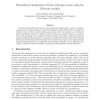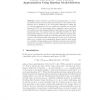124 search results - page 13 / 25 » Basis function construction for hierarchical reinforcement l... |
CVPR
2007
IEEE
14 years 10 months ago
2007
IEEE
We present a hierarchical generative model for object recognition that is constructed by weakly-supervised learning. A key component is a novel, adaptive patch feature whose width...
CDC
2010
IEEE
13 years 3 months ago
2010
IEEE
Abstract-- We consider reinforcement learning, and in particular, the Q-learning algorithm in large state and action spaces. In order to cope with the size of the spaces, a functio...
JBCB
2010
13 years 3 months ago
2010
Protein function prediction is an active area of research in bioinformatics. And yet, transfer of annotation on the basis of sequence or structural similarity remains widely used ...
PKDD
2009
Springer
14 years 3 months ago
2009
Springer
Abstract. Feature selection in reinforcement learning (RL), i.e. choosing basis functions such that useful approximations of the unkown value function can be obtained, is one of th...
ECML
2005
Springer
14 years 2 months ago
2005
Springer
This paper investigates a novel model-free reinforcement learning architecture, the Natural Actor-Critic. The actor updates are based on stochastic policy gradients employing Amari...


